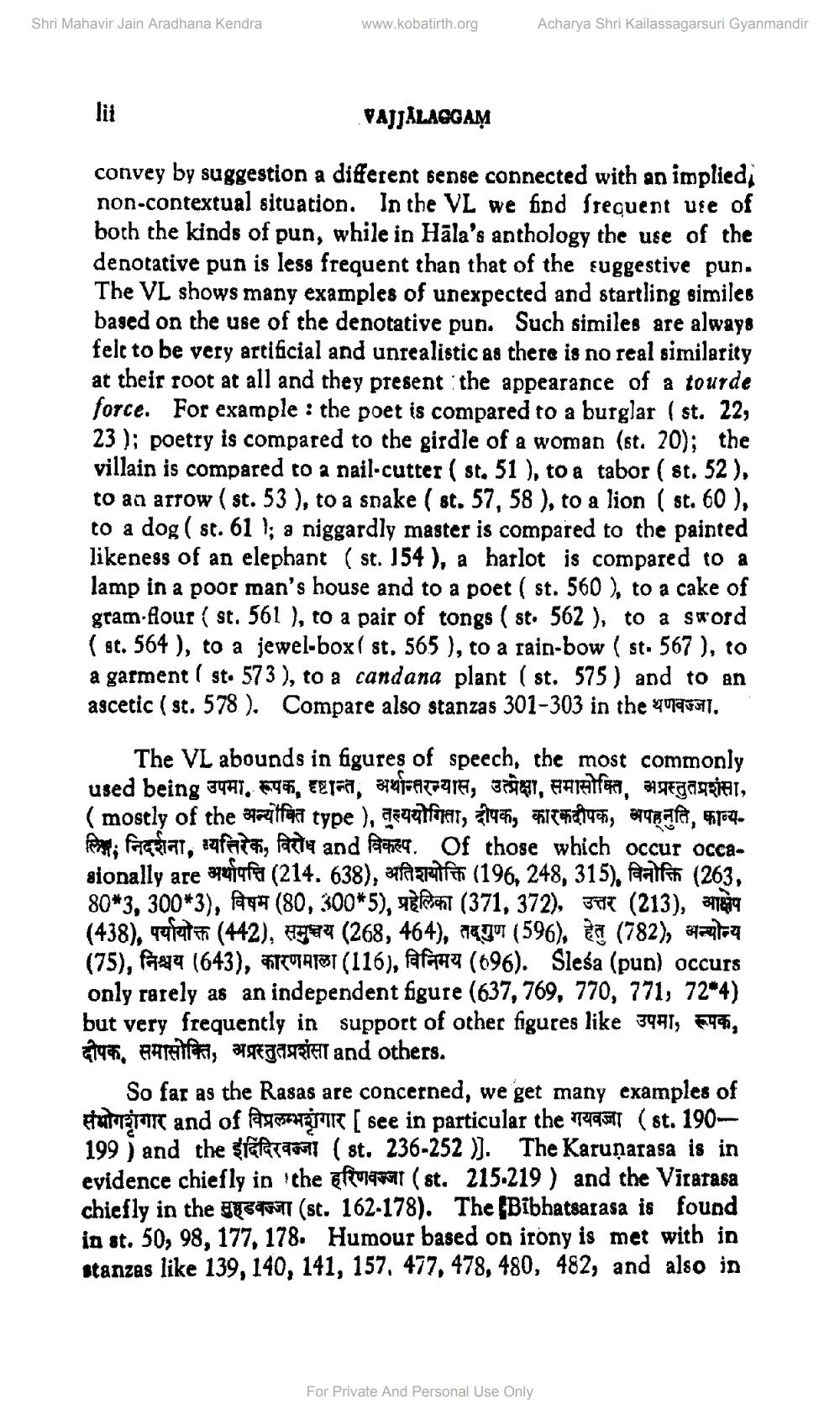________________
Shri Mahavir Jain Aradhana Kendra
www.kobatirth.org
Acharya Shri Kailassagarsuri Gyanmandir
VAJJALAGGAM
convey by suggestion a different sense connected with an implied, non-contextual situation. In the VL we find frequent use of both the kinds of pun, while in Hāla's anthology the use of the denotative pun is less frequent than that of the suggestive pun. The VL shows many examples of unexpected and startling similes based on the use of the denotative pun. Such similes are always felt to be very artificial and unrealistic as there is no real similarity at their root at all and they present the appearance of a tourde force. For example : the poet is compared to a burglar ( st. 22, 23 ); poetry is compared to the girdle of a woman (st. 20); the villain is compared to a nail-cutter ( st. 51 ), to a tabor ( st. 52), to an arrow ( st. 53 ), to a snake ( st. 57, 58 ), to a lion ( st. 60 ), to a dog ( st. 61 ); a niggardly master is compared to the painted likeness of an elephant (st. 154 ), a harlot is compared to a lamp in a poor man's house and to a poet ( st. 560 ), to a cake of gram flour ( st. 561 ), to a pair of tongs ( st. 562 ), to a sword ( st. 564 ), to a jewel-boxi st. 565 ), to a rain-bow ( st. 567 ), to a garment ( st. 573), to a candana plant ( st. 575) and to an ascetic ( st. 578 ). Compare also stanzas 301-303 in the 1975|.
The VL abounds in figures of speech, the most commonly used being aYAT, 545, reina, 37e=ATEGIE, grøn, FarAIGA, regasihi, (mostly of the greitfaa type ), qaqalitat, 197, for 2014, para, $164. er en forestar, afaceri, fata and Parenta. Of those which occur occasionally are 291919 (214. 638), sari (196, 248, 315), falfin (263, 80*3, 300*3), 9 (80, 300*5), FERT (371, 372), 3717 (213), 37 (438), waretti (442), ayaa (268, 464), 1400 (596), en (782), alca (75), fava (643), TTTARSI (116), Afana (696). Sleśa (pun) occurs only rarely as an independent figure (637, 769, 770, 771, 72*4) but very frequently in support of other figures like उपमा, रूपक, 1995, AATETIT, adeganist and others.
So far as the Rasas are concerned, we get many examples of संभोगशंगार and of विप्रलम्भशंगार [ see in particular the गयवज्जा (st. 190199 ) and the sfataraan ( st. 236-252 )]. The Karunarasa is in evidence chiefly in the finaal (st. 215-219 ) and the Virarasa chiefly in the arch (st. 162-178). The Bibhatsarasa is found in st. 50, 98, 177, 178. Humour based on irony is met with in stanzas like 139, 140, 141, 157, 477, 478, 480, 482, and also in
For Private And Personal Use Only




